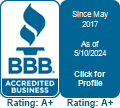Greenville and Sanford, ME (207) 695-3645
Farmington, NH (603) 755-9181
WE DO IT RIGHT THE FIRST TIME
Waterwell Services Done Right the First Time
Call Us For Service Today!
FAQ
Well Drilling Questions
1. Improper voltage or voltage surges
The motor has to have good voltage in order to operate. Improper voltage or voltage surges are the most common causes of electrical heat. The first thing to do is make certain the voltage coming in matches the motor you're using. The larger the tank, the less the pump starts and stops. Starting and stopping is bad for every component of the system.
2. Inadequate tank size or a poorly maintained tank
A tank too small for the system or one not properly maintained will lead to rapid cycling and eventually wear out the motor.
3. Improper wire sizing or bad splices
Submersible motor manufacturers size wire per the recommended voltage loss in the United States National Electrical Code. You also need to make sure the proper voltage is reaching the motor through good connections, contacts, and proper wire sizing. It's important to follow all state, local, and national electrical requirements and guidelines.
4. What's the difference between groundwater and surface water?
Surface water is just what the name implies; it is water found in a river, lake or other surface impoundment. Surface water is exposed to many different contaminants, such as animal wastes, pesticides, insecticides, industrial wastes, algae and many other organic materials which is not purified water.
Groundwater is water that is contained in a subsurface layer of soil or rock. There are many sources that recharge the supply of groundwater, including rain that soaks into the ground, rivers that disappear underground and melting snow. Groundwater commonly contains less contamination than surface water because the rock tends to act as a filter to remove some contaminants but is not as clean to drink as purified water.
Groundwater is water that is contained in a subsurface layer of soil or rock. There are many sources that recharge the supply of groundwater, including rain that soaks into the ground, rivers that disappear underground and melting snow. Groundwater commonly contains less contamination than surface water because the rock tends to act as a filter to remove some contaminants but is not as clean to drink as purified water.
5. My well contains Total Coliform or E. coli bacteria, what should I do?
If your well contains Total Coliform and/or E. coli bacteria, you are advised not to use your well water for drinking or cooking until the well has undergone a shock chlorination treatment. The well should be properly treated with chlorine (bleach), resampled, and determined to be free of Total Coliform and/or E. coli before using for drinking and cooking. You can contact us to have us chlorinate your well.
6. Buried Wells
Top of wells buried below ground level needs to be extended a minimum of 12 inches above ground level.
BROWSE OUR WEBSITE
CONTACT INFORMATION
Office Locations:
296 Chestnut Hill Rd Farmington, NH 03835
Greenville and Sanford, ME
Email: goodwinjudd@yahoo.com






Content, including images, displayed on this website is protected by copyright laws. Downloading, republication, retransmission or reproduction of content on this website is strictly prohibited. Terms of Use
| Privacy Policy
